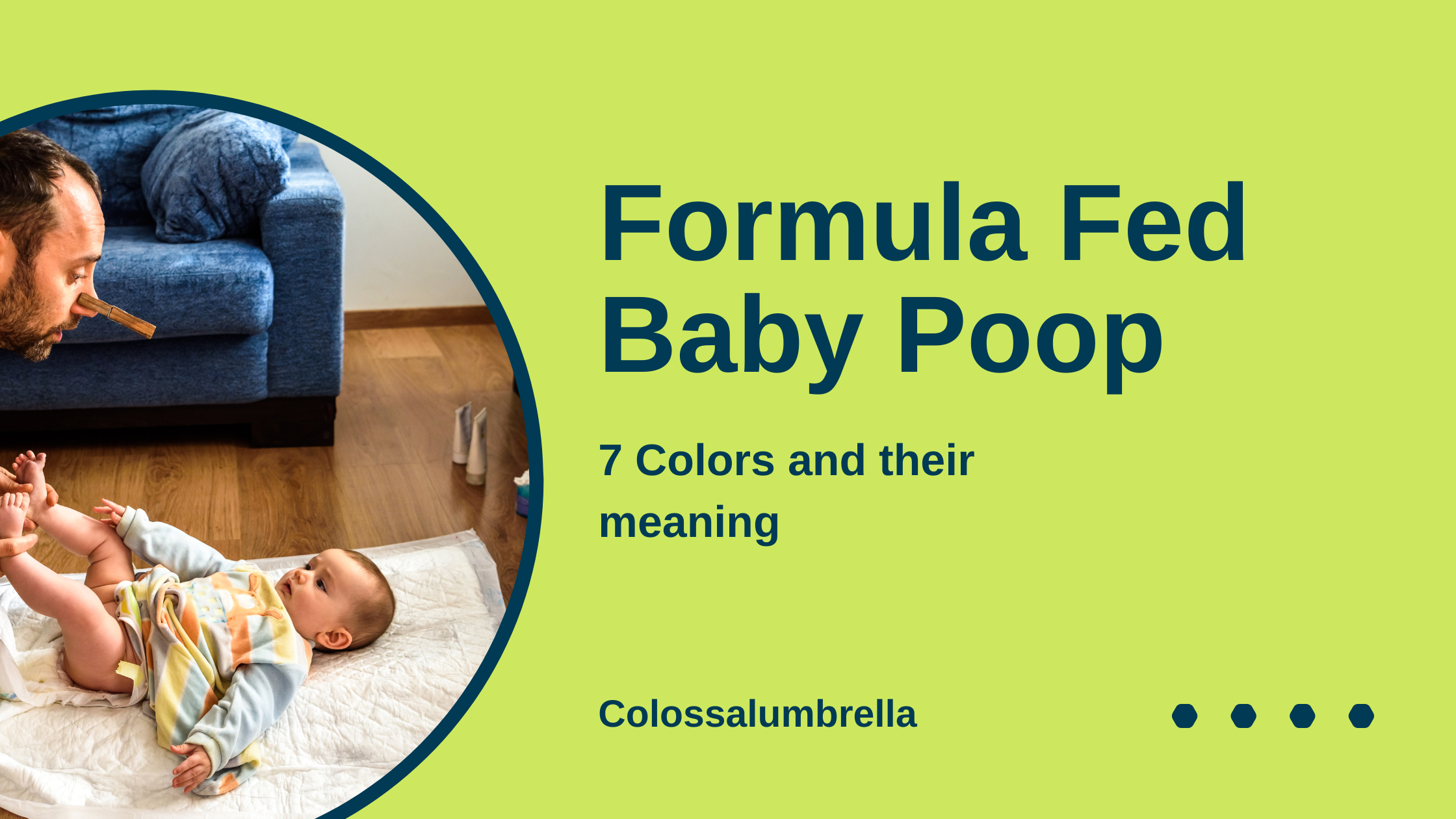Contents
Welcome to the wild and wacky world of formula fed baby poop! If you’re a new parent, chances are you have already become an expert in analyzing, dissecting, and discussing the contents of your little one’s diapers. And let’s face it, it is a topic that’s hard to avoid when you’re knee-deep in dirty diapers day in and day out.
Now, I know what you’re thinking. “Why on earth would I want to read an entire blog post about baby poop?” Well, it is because as new parents, we tend to worry about every little thing when it comes to our precious bundles of joy. And nothing can make us panic faster than a change in poop color or consistency.
Formula-fed babies have a unique set of characteristics when it comes to their poop. Understanding what is normal and what may indicate a problem can help parents navigate this aspect of their baby’s health. In this blog post, I will try to cover everything related formula fed baby poop, the color, consistency, frequency, and signs of constipation in formula fed baby poop.
Subscribe to my blog for Parenting tips that will make you feel like a pro, and get access to exclusive free Printables that will keep your little ones busy and happy!
Baby’s First Poop: Meconium
Just like breastfed babies, formula-fed infants also pass meconium as their first stool. Meconium is a greenish-black, sticky substance composed of amniotic fluid, mucus, and skin cells. It usually appears within the first 24 hours after birth. To make cleaning easier, applying petroleum jelly to your baby’s bottom before their first bowel movement is recommended.
Transition in Color and Texture
Around 2 to 4 days after birth, your formula fed baby poop will undergo a transition in color and texture. This change is a sign that their digestive system is digesting the formula properly. Unlike breastfed baby poop, which ranges from yellow to green or brown, formula fed baby poop falls within the brown color spectrum. Shades of yellow-brown, tan-brown, and green-brown are considered normal. It may have a slightly stronger odor than breastfed baby poop but less than that of babies who have started eating solid foods.
Normal Characteristics of Formula Fed Baby Poop
Color: Formula fed baby poop can vary in color, typically ranging from yellow to brown. The hue may depend on the type of formula used, but generally, it should be consistent and within this color spectrum.
Consistency: The consistency of formula fed baby poop is typically firmer than that of breastfed babies. It often resembles peanut butter or even Play-Doh, maintaining its shape when expelled. However, variations in consistency can occur, influenced by factors such as hydration levels and the baby’s digestive system.
Odor: Formula fed baby poop tends to have a distinct, stronger odor compared to breastfed baby poop. This is due to the composition of the formula and the way the baby’s digestive system breaks it down.
Factors Influencing Formula Fed Baby Poop
- Type of Formula: The type of formula used can impact the characteristics of baby poop. Different formulas contain varying ingredients and nutrients, which can affect the color, consistency, and odor of the stool.
- Feeding Frequency: The frequency of feedings can also influence the appearance of baby poop. If a baby is fed more frequently, the poop may be softer and more frequent. On the other hand, less frequent feedings can result in firmer stools.
- Baby’s Age: As babies grow and their digestive systems develop, changes in the characteristics of their poop are expected. Newborn poop tends to be more liquid and gradually transitions to a thicker consistency as they mature.
- Baby’s Health: The overall health of the baby can impact the appearance of their poop. Illness, digestive issues, or food sensitivities may lead to changes in color, consistency, and odor.
Abnormal Characteristics of Formula Fed Baby Poop
- Hard, Dry Stools: If a formula-fed baby’s poop becomes hard and dry, resembling small pellets or pebbles, it could indicate constipation. Constipation is characterized by infrequent and difficult bowel movements. It may be caused by factors such as dehydration, insufficient fiber intake, or a formula that is not well-suited to the baby’s digestive system.
- Watery or Runny Stools: While formula fed baby poop is generally firmer than breastfed baby poop, excessively watery or runny stools can be a cause for concern. This may indicate diarrhea, which can be caused by a variety of factors, including an infection, a reaction to a particular ingredient in the formula, or improper formula preparation.
- Green Stools: Formula-fed babies may occasionally pass green stools, which can be attributed to factors such as an imbalance of gut bacteria, rapid digestion, or the presence of bile in the stool. However, persistent green stools or other abnormal changes in color should be monitored and discussed with a healthcare provider.
- Mucus in Stools: The presence of mucus in a formula fed baby poop can be a sign of inflammation or irritation in the digestive tract. It may be accompanied by other symptoms, such as fussiness or poor appetite. If mucus is consistently present in the stool, medical advice should be sought.
- Blood in Stools: Discovering blood in a baby’s poop can be alarming for parents. Blood may appear as streaks or spots in the stool and can be caused by various factors, including food allergies, anal fissures, or digestive issues. It is important to consult a healthcare provider to determine the cause and appropriate course of action

Signs of Potential Problems
- Persistent Changes in Poop Characteristics: If there are consistent and significant changes in the baby’s poop, such as prolonged diarrhea, persistent constipation, or unusual colors, it is important to seek medical advice. These changes may be indicative of an underlying health issue or intolerance to certain ingredients in the formula.
- Poor Weight Gain: A formula-fed baby’s poop can provide valuable insights into their overall health and nutrition. If a baby consistently has abnormal poop characteristics accompanied by poor weight gain or failure to thrive, it is essential to consult a healthcare provider to evaluate the baby’s feeding routine and overall well-being.
- Irritability or Discomfort: Changes in poop characteristics, especially when accompanied by irritability, fussiness, or signs of discomfort, can indicate digestive issues. Consulting a healthcare provider can help identify and address the underlying cause, ensuring the baby’s comfort and well-being.
- Vomiting: Frequent or forceful vomiting, especially if it is accompanied by weight loss or dehydration, requires immediate medical attention. Vomiting can be a sign of a serious underlying condition that needs to be assessed and treated by a healthcare professional.

Changes with Solid Food Intake
As your baby begins to eat solid foods, usually around 6 months of age, you will notice a significant change in the color and texture of their poop. It will likely become thicker and smellier. The color may vary depending on the foods they consume, and you might even spot bits of undigested food in their stool. It is important to note that while light-colored poop is normal, white or pale, chalky poop should be brought to the attention of your baby’s doctor, as it may indicate a liver or gallbladder problem.
Frequency of Bowel Movements
The frequency of bowel movements in formula-fed babies can vary widely, and there is no magic number that defines what is normal. Each baby has their own individual pattern. In the first few days after birth, newborns often have several bowel movements a day. Some babies may even poop after each feeding during their first month. However, this frequency may slow down by around 6 weeks. It is common for formula-fed babies to have at least one bowel movement each day, with occasional days of no poop. As they approach the age of 6 months, they may have two bowel movements a day.
Signs of Constipation
Constipation can be a concern for formula-fed babies, but it is important to differentiate between normal changes in bowel movements and actual constipation. Signs that your formula-fed baby may be constipated include:
- Hard Texture: If your baby’s poop is hard, resembling little clay balls or large, firm, and formed stools, it may indicate constipation. However, it is essential to note that the consistency should be similar to peanut butter under normal circumstances.
- Straining: Babies often strain during bowel movements, even with soft stools. However, if your baby strains for more than 10 minutes without passing stool, it may be a sign of constipation.
- Blood in Stool: If you notice a small amount of blood in your baby’s poop, it may be caused by straining and irritating the anus as the stool is passed.
- Discomfort and Fussiness: Constipated babies may be fussy and seem uncomfortable due to the difficulty of passing stool.
- Increased Spit-Up: Some formula-fed babies may experience increased spit-up when constipated.
It is worth mentioning that constipation can occur when babies start eating solids, during illness, or when they become dehydrated. In rare cases, constipation in newborns may be a symptom of underlying conditions such as cystic fibrosis, Hirschsprung’s disease, or hypothyroidism. If you have any concerns about your baby’s bowel movements, especially if accompanied by vomiting or other worrisome symptoms, consult your baby’s healthcare provider.
Remedies for Constipation
If your formula-fed baby is constipated, several remedies may help alleviate the issue. It is important to note that these remedies should be used occasionally and not become a long-term solution. If constipation persists, it is best to seek advice from a healthcare professional. Here are some remedies you can try:
- Bicycle Legs: Gently move your baby’s legs in a cycling motion, as if they are riding a bicycle. This can help stimulate their digestive system.
- Warm Bath: A warm bath can relax your baby’s muscles and help stimulate bowel movements.
- Rectal Stimulation: Gentle rectal stimulation, such as using a rectal thermometer or a gas-relieving product, may help get things moving. However, it is important to use rectal stimulation sparingly and consult with your pediatrician before attempting it.
- Water or Juice: If your baby has started eating solids, offering a few ounces of water or pear juice may help soften their stool and promote bowel movements. It is crucial to ensure your baby stays hydrated.
- Glycerin Suppositories: Glycerin suppositories can be used on an occasional basis to relieve constipation. However, it is essential to consult with your doctor, especially if your baby is younger than a year.
- Fiber-Rich Foods: Incorporating fiber-rich foods into your baby’s diet can help soften their stool. Vegetables and whole grains, such as brown rice and whole-wheat pasta, are excellent choices.
Is Grunting During Pooping Normal?
Many parents wonder if it is normal for their baby to grunt during bowel movements. The answer is yes! Babies often make grunting noises and strain while pooping due to their underdeveloped abdominal muscles. This effort and energy required for pooping engage the diaphragm, resulting in sound effects. It is also common to see babies making faces while they poop. However, it is important to note that grunting alone does not necessarily indicate constipation.
Baby Poop Colors and What They Mean
While the color of your formula fed baby poop can vary depending on their diet and other factors, certain colors may indicate potential health issues. Here is a breakdown of baby poop colors and what they might mean:
- Green Baby Poop: Greenish-tan poop is normal for formula-fed infants. It may be caused by the iron in the formula or indicate that the baby is recovering from a stomach bug. If your baby displays discomfort or fussiness along with green poop, it could be a sign of a cow’s milk allergy or an imbalance between foremilk and hindmilk in breastfed babies.
- Black Baby Poop: Newborns often pass black meconium as their first poop. However, if your baby’s poop remains black after a few days, it may indicate inadequate nutrition or a potential gastrointestinal bleeding issue. Consult your doctor if you notice black poop.
- White Baby Poop: Chalky, grayish, or white poop in a formula-fed or breastfed baby is rare and should be reported to your pediatrician. It may be a sign of liver dysfunction or a condition known as biliary atresia.
- Yellow Baby Poop: Mustard yellow is a normal color for both breastfed and formula-fed infants. If your baby’s poop is bright yellow, it may be a result of medications or the food eaten by the mother.
- Gray Baby Poop: Gray poop in a baby who is eating solids may be a result of their diet. However, if your baby has not started consuming solid foods, gray poop may indicate a liver or gallbladder problem.
- Orange Baby Poop: Orange-colored poop can be seen after the introduction of certain solid foods, such as carrots and sweet potatoes. In breastfed babies, artificially colored foods consumed by the mother can also lead to orange-tinted stool.
- Red Baby Poop: Flecks of red in a baby’s poop are usually harmless and can be caused by small amounts of blood from cracked nipples during breastfeeding or straining while constipated. However, if the stool appears genuinely bloody or is bright red, it may indicate an infection, allergy, gastrointestinal injury, or other medical concern.
When to Seek Medical Attention
While most variations in formula fed baby poop are normal, certain signs may warrant medical attention. If you notice any of the following, contact your baby’s healthcare provider:
- Absence of Bowel Movements: If your breastfed baby hasn’t pooped in over three days or your formula-fed baby hasn’t pooped in over five days, it is essential to consult with a healthcare professional.
- Abnormal Texture: If your baby’s poop is thick, hard, or pebbly, it may indicate constipation. Seek medical advice if this persists.
- Unusual Colors: White, gray, or clay-colored poop should be reported to your pediatrician as it may signify a liver or gallbladder problem.
- Other Concerning Symptoms: If your baby’s poop is accompanied by high fever, excessive discomfort, vomiting, or other worrisome symptoms, seek immediate medical attention.
Remember, you know your baby best. If you notice anything unusual or have concerns about your baby’s poop, do not hesitate to reach out to your healthcare provider. They can provide guidance and ensure your baby’s health and well-being.
People also ask
How often should a formula fed baby poop?
Formula-fed babies typically have one bowel movement per day or less frequently. Less frequent bowel movements are usually not concerning if the baby is healthy and active.
What should formula fed poop look like?
Formula fed baby poop is firmer and pastier compared to breastfed babies. It is usually yellow or brown in color and has a more formed appearance.
Do formula-fed babies have trouble pooping?
Formula-fed babies may experience difficulty passing stool, leading to constipation. Factors like dehydration or certain formula ingredients can contribute. Consult a pediatrician if your baby shows signs of discomfort.
What does diarrhea look like in formula-fed babies?
Diarrhea in formula-fed babies is characterized by frequent, watery bowel movements. The stool appears runny and more explosive than usual. Monitor hydration and seek medical advice if necessary.
What does bad formula poop look like?
Bad formula poop may be unusually watery, excessively hard, or contain mucus or blood. Contact a pediatrician if you notice any abnormal changes in your baby’s stool.
How do I know if formula is bad for my baby?
Consistent discomfort, excessive gas, persistent vomiting, or concerning changes in bowel movements after consuming a particular formula may indicate it’s not suitable. Consult a pediatrician for evaluation and guidance.
Conclusion
Understanding formula fed baby poop is valuable for parents and caregivers, providing insights into the baby’s digestive health. By recognizing the normal characteristics, understanding the factors influencing poop appearance, and identifying potential issues, parents can ensure the well-being of their formula-fed babies. Addressing common concerns, recognizing signs of potential problems, and seeking medical advice when needed are essential steps in promoting healthy digestion and overall growth. Remember, every baby is unique, and consulting a healthcare provider is always recommended for personalized guidance and support.
Disclaimer: The content of this blog is for informational purposes only and is not intended to be a substitute for professional medical advice, diagnosis, or treatment. Always seek the advice of your physician or other qualified healthcare providers with any questions you may have regarding a medical condition.
I would stay connected and keep you updated with parenting tips, pregnancy guides, creative ideas, easy crafts, and Free Printables. Subscribe to Colossalumbrella to get new ideas delivered to your inbox. Follow me on Facebook, Pinterest, Twitter, and Instagram.

2 thoughts on “Formula Fed Baby Poop: 7 Poop Colors and their meaning”